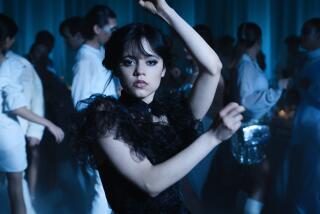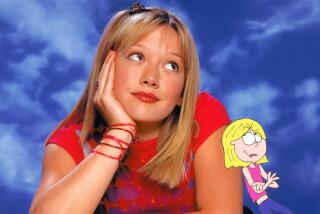New kids on the comic bloc
ALL around the city, wherever billboards bloom, one has lately seen a drawing of an African American child with a wedge-shaped head and ferociously knitted brows over the words, “I don’t mean ‘*#&%*$’ in a disrespectful way.” This is to announce that “The Boondocks,” Aaron McGruder’s socially critical comic strip about “angry black children” living with their grandfather in an upscale, mostly white suburb, is coming to television -- it premieres next Sunday on Cartoon Network, as part of its late-night Adult Swim franchise -- and joining the relatively small cadre of daily comics that have leapt to TV: “Peanuts,” “Doonesbury,” “Bloom County,” “Garfield,” “Cathy,” “Dilbert” and not so many others.
That “The Boondocks,” long considered “dangerous” notwithstanding that it’s carried in hundreds of mainstream newspapers, has made it to TV says something not only about the strip’s impact but about what’s happened to television in the years since Charlie Brown bought that sad little Christmas tree. There is not only a wider market for cartoons, but -- given the way cable TV has created a thirst for the sensational that also drives the content of broadcast TV -- a wider market for cartoons perceived as edgy.
There are cartoons for everyone these days -- for all ages, tastes, levels of sophistication. From its old ghetto of network Saturday mornings and afternoon local TV, animation has become the backbone of three basic cable networks (Cartoon Network, Nickelodeon and the Disney Channel, which also has its Toon Disney spinoff) and a force in the fortunes of Comedy Central, where “South Park” and “Drawn Together” live; MTV, with “Daria” and “Beavis and Butt-head”; and Fox, which over a decade ago helped drive the cartoon revival with the historically conscious Warner Bros.-produced “Tiny Toons,” “Animaniacs” and “Pinky and the Brain” and which at times has had only “The Simpsons” and “King of the Hill” to point to with pride in its prime-time lineup.
It’s not so much an animation explosion as it is a continuing accretion of cartoons -- like a growth of colorful kudzu. And much if not most of it is very good indeed, more reliably inventive, witty, lively and fun than what the makers of live-action television offer. Perhaps it’s because cartoons are imagined from the ground up and because they’re increasingly made by people who actively, even nerdishly love the form and know its history -- and at a time when Flash and other computer animation technologies make it possible to affordably realize sophisticated visual ideas, and at the same time have encouraged a kind of DIY/indie/punk aesthetic that Cartoon Network in particular has embraced.
Given an expanding audience and the myriad possibilities of a form whose very job it is to make the impossible happen, it’s no wonder that Cartoon Network has split into several parts: Adult Swim, which retails an aesthetic of sullen mayhem and radical anomie on such shows as “Aqua Teen Hunger Force,” “Harvey Birdman, Attorney at Law,” the new “Squidbillies” and “Lucy, the Daughter of the Devil”; the “regular” programming, such as “Foster’s Home for Imaginary Friends” and the “Miguzi” and “Toonami” action blocs; and the new early morning “Tickle U.,” which takes an avowedly noneducational approach to preschool entertainment.
“The Boondocks” is the first Cartoon Network series to be created by an African American and likely the first black cartoon on any channel to exercise, as McGruder titled an anthology of his strips, “A Right to Be Hostile.” In one episode, Huey addresses a garden party to which his grandfather has been invited by the man who owns the company that holds the loan on their house: “Jesus was black, Ronald Reagan was the devil and the government is lying about 9/11.” But the people he wants to provoke only find him adorable. “They’re not worried about anything,” he says in disgust. “They’re rich. No matter what happens, they just keep applauding.”
There’s a poignancy there that works only because it’s drawn, in a style inspired (like the strip itself) by Japanese comics and anime, and paced like a dream. Live actors would overwhelm the moment, turn it sitcomical. (The boys aren’t even voiced by children but by actress Regina King.) And Huey is, after all, adorable, in his way -- he’s cousin to Charlie Brown and every other grade-school cartoon character given adult eloquence (and anxieties). At the same time King’s performance catches the kid in him, which redoubles the poignancy.
Indeed, for all its button-pushing language, bad attitude, plain raunchiness and the novel sight of an 8-year-old wannabe-thug drawing a bead on the head of an old white man with a pellet gun, the show is a gentle one. As far as edginess, it’s no match for “South Park,” where a popular word for “feces” was famously bleeped 162 times in a single episode, pedophilia is considered a viable subject for satire and Kenny dies horribly in every episode. By the standards of Adult Swim -- with its often plotless cartoons made of uncomfortable silence, aggressive banality and sometimes crude and even ugly graphics -- the show is almost conventional: It has a graspable premise, trackable narrative, characters with some kind of sentimental attachment to one another. And though it is skeptical about humans’ ability to smell even the coffee they brew themselves, there’s nothing here more fundamentally disturbing than Homer Simpson’s message to his children: “You tried your best and you failed miserably. The lesson is: Never try.”
A genre true to its form
LIVE-ACTION television counterfeits reality, but a cartoon is a real cartoon, the thing itself, a place of heightened color and speed and sound, even of language. (Cartoon writers seem especially to relish three- and four-syllable words: confiscation, shenanigans, imbeciles, etiquette, saliva, corrugated, anticipate, pheromone. “You’re not going to exploit innocent amphibians for some juvenile revenge scheme?” one character asks another on “Danny Phantom.”) Bound neither to the physics nor the biology of the real world -- though they use both to comic effect -- cartoons are formally free in a way that also encourages freedom of content. It makes a space where the rules do not apply. As on Cartoon Network’s wonderful “Camp Lazlo,” for example, a monkey-child may become best friends with the lamprey attached to his head, or a Scoutmaster moose may marry a tree. Or as on WB’s “Mucha Lucha,” currently on the Cartoon Network, every character can be a masked Mexican wrestler. Many are awash in violence -- cartoon violence, which may be registered and dismissed in an instant -- and almost all delight in bodily fluids and functions.
On “The Boondocks,” Huey and Riley are characters in perpetual revolt, but rebellion is the birthright, as it were, of every cartoon hero. Represented by the likes of SpongeBob SquarePants and Dexter in his laboratory, they tend to be underdogs, oddballs or outsiders. “Popeye” notwithstanding, the lesson they teach is not to eat your spinach, real or metaphorical, but to not eat it if spinach isn’t your thing. “The stories present a playful look at the universal theme of adolescence: individuality versus conformity,” Dave Polsky says of his delightful Disney Channel show “The Buzz on Maggie,” about a tweenage fly-girl and her friends and family.
If cartoons are a release for adults, they are an education for kids. Whether it’s Bugs Bunny or the Powerpuff Girls, they offer models of quick thinking and self-reliance. As in life, grown-ups are of limited assistance -- the older the show’s target audience, the less helpful they are -- and this is true on “The Boondocks” as well, where Granddad, played by John Witherspoon, is a font of bad advice proceeding from an outmoded understanding of the world. In shows aimed at children, we find again and again kids, tweens or teenagers charged with keeping the world safe from monsters, supervillains and/or aliens while trying to negotiate the rocks and rapids of ordinary school and home life; these include Cartoon Network’s “The Life & Times of Juniper Lee,” Disney Channel’s “American Dragon: Jake Long” and “Kim Possible”; and Nickelodeon’s “Danny Phantom.”
That such superheroics should be a dominant trope is no surprise. Like the comics, cartoons are children’s things made by adults who are not finished with children’s things. The reason the best of them have cross-generational appeal is not that they contain jokes for adults and jokes for children but that everything in them represents that doubleness: The dumbest jokes are there for the adults too, just as the smarter ones are there for the kids who know enough to get them -- and for the kids who don’t, they stand for the fact that there are things still to know, that (pace Homer Simpson) there is something to aspire to: Bugs Bunny cool. And in the meantime, like Huey and Riley, you try to think for yourself. That’s what the cartoons tell us.
More to Read
The biggest entertainment stories
Get our big stories about Hollywood, film, television, music, arts, culture and more right in your inbox as soon as they publish.
You may occasionally receive promotional content from the Los Angeles Times.











